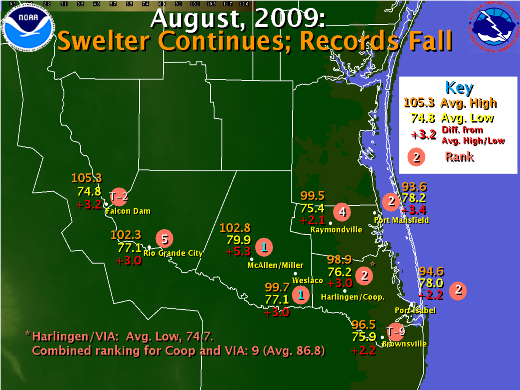 Heatwaves, Drought Dominate Summer 2009 All Time Records are Crushed in McAllen |
||||||||||||||||||||||||||||||||||||||||||||||||||||||||
|
August, in Review Table 1 shows 2009 average August temperatures, rankings, and standing or broken records for locations where sufficient data were available. Similar to July, both McAllen/Miller Airport and the nearby cooperative observing station at the water treatment plant shattered their prior records set in 1998. Miller airport was just under 2.1°F (2.04°F) above its 1998 benchmark, and the water treatment plant was a healthy 1.3°F ahead of the mark. Weslaco had the next record, and a healthy difference (0.7°F) above its prior record. To put these departures in perspective, note once again that the value of 2.1°F is roughly one standard deviation about the August mean temperatures. See box below for more unique information from McAllen Miller this summer. A discussion of the August statistical relationship, which nearly mirrors that in July, can be found in the July 2009 Review. Final August departures from average are shown in the map above. For the three airport locations, temperatures were 2.2°F above average at Brownsville (86.2°F), 2.3 degrees above Harlingen/Valley (86.8°F) and 5.3°F above average at McAllen/Miller (91.4°F).
¹Data incomplete, especially early in 20th century. Summer 2009’s Searing Heat Summer (June through August) 2009 was a case where both atmospheric and earth science puzzle pieces fit together to create a feedback loop: Favorable atmospheric patterns maintained the hot, windy, and rain free weather, and the excessive heat at the earth’s surface was reinforced by the parched landscape, allowing the sun’s energy to be used exclusively for heating, which in turn increased surface winds between the relatively cool Gulf and the hot land more than even a relatively hot atmospheric pattern would allow. The winds accelerated the pace of drying, leading to more heating, as the cycle continued through the heart of summer. By the end of August, a break in the pattern would allow moisture to pool along the Rio Grande into northern Mexico; showers and thunderstorms, lighter winds, increased humidity, and longer nights would finally tame the heat wave. This pattern of endless heat ensured that 2009 would challenge 1998 for heat supremacy in Deep South Texas. Temperature data collected for June through August showed most stations in Deep South Texas and the Rio Grande Valley in the top 5 hottest, all time. McAllen Miller Airport was nearly 1°F above its all time average, while Harlingen’s cooperative station was in second place. Brownsville, with the longest period of record – more than 130 years – ended in 6th. Table 2 below shows the 2009 summer averages, historical rank, and standing record. The Legacy |
||||||||||||||||||||||||||||||||||||||||||||||||||||||||
| McAllen Miller Airport: Wow!
Some interesting facts from McAllen/Miller Airport as Summer 2009 Closes:
|
||||||||||||||||||||||||||||||||||||||||||||||||||||||||
¹Data incomplete, especially early in 20th century. |
||||||||||||||||||||||||||||||||||||||||||||||||||||||||